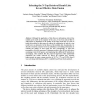Free Online Productivity Tools
i2Speak
i2Symbol
i2OCR
iTex2Img
iWeb2Print
iWeb2Shot
i2Type
iPdf2Split
iPdf2Merge
i2Bopomofo
i2Arabic
i2Style
i2Image
i2PDF
iLatex2Rtf
Sci2ools
CICLING
2010
Springer
2010
Springer
Selecting the N-Top Retrieval Result Lists for an Effective Data Fusion
Although the application of data fusion in information retrieval has yielded good results in the majority of the cases, it has been noticed that its achievement is dependent on the quality of the input result lists. In order to tackle this problem, in this paper we explore the combination of only the n-top result lists as an alternative to the fusion of all available data. In particular, we describe a heuristic measure based on redundancy and ranking information to evaluate the quality of each result list, and, consequently, to select the presumably n-best lists per query. Preliminary results in four IR test collections, containing a total of 266 queries, and employing three different DF methods are encouraging. They indicate that the proposed approach could significantly outperform the results achieved by fusion all available lists, showing improvements in mean average precision of 10.7%, 3.7% and 18.8% when it was used along with Maximum RSV, CombMNZ and Fuzzy Borda methods.
CICLING 2010 | Data Fusion | Fuzzy Borda Methods | IR Test Collections | Natural Language Processing |
| Added | 23 Aug 2010 |
| Updated | 23 Aug 2010 |
| Type | Conference |
| Year | 2010 |
| Where | CICLING |
| Authors | Antonio Juárez-González, Manuel Montes-y-Gómez, Luis Villaseñor Pineda, David Pinto Avendaño, Manuel Alberto Pérez-Coutiño |
Comments (0)

